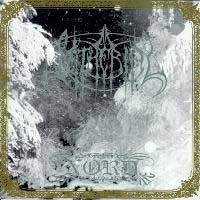Review: Intensely black metal, this music differentiates itself through reduction in patterned substructures larger than the riff. Rhythmic breaks and cyclic riffs leading to one another through prescribed, rigorous, court-dance patterns of grace and rhythmic induction of the meta-ideas of each song.
There are intensely individual structures to these songs, although the cohesion is not managed entirely cleanly; many parts of this album rely heavily upon patterned (Emperor) riffs and second-wave black metal derivations that sometimes work as heavy music but in some instances fall flat as an outpouring of rock n roll, a hated happy creature from the lands of light.
Tracklist:
1. In The Still of a Northern Fullmoon (12:00)
2. Mörkrets Tid (5:33)
3. Över Det Blodtäckta Nord (14:00)
4. I Nattens Famn (4:16)
5. För Dem Mitt Blod (4:10)
6. I skuggors Dunkla Sken (5:23)
Length: 45:24
|

Copyright © 1996 Napalm
|
Percussion is also reminiscent of Emperor, as are at least indirectly most aesthetic elements of this band. Bard Faust's high-hat/snare power play, patented with "In the Nightside Eclipse," develops here as a more consistent effect. Keyboards often seem to taken from an Emperor album and tempo changes are reminiscent of earlier material by the same band, but vocals are entirely different in the squawking screeching holocaust of abrasive blast of vocal anti-text. The style that emerges however has ancestors in many of the upper echelon black metal bands.
For example, the sometimes predictable tendency of the band to break into slower, strum-driven rolling melodic interludes, originates in the epic tendencies of Immortal, Emperor and other more-conventional and musically literate bands. Overlaid on this foundation/point of entry to genre is the melodic acuity of a modern black metal band with sparse, varied, and mellifluous combinations of simple elements interacting on a great shifting uberrhythmic pulse that drives even the variants of a profound chaos into death and stillness when its articulation has expired.
The intricacy of these patterns and their specific signature styles distinguish this album as original despite aesthetic similarities to foundational black metal acts. Although not as complex the originals through a discontinuity that emerges from a lesser higher-level conception of the art, and consequently an inexplicative expression of fascination at times little more than a vehicle of invented mental structures communicated through common experience. In the midst of interlocking patterns and the math of tonal balance, sonorous musicality alongside an ability to write ripping tunes that have individuality, hooks and lasting appeal generate from this context a self-recognizing intent toward fulfillment of that style.